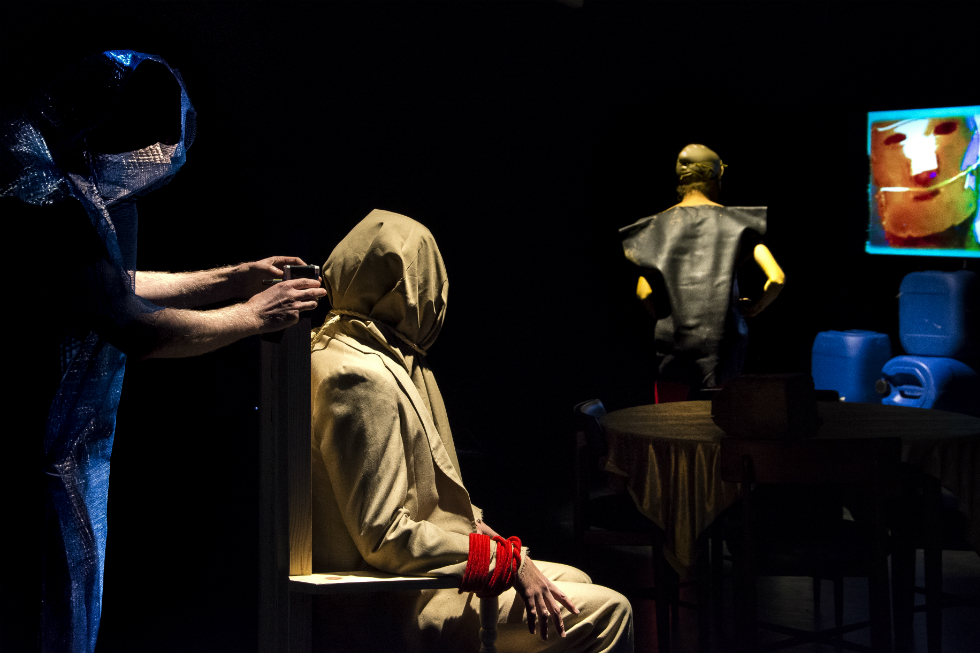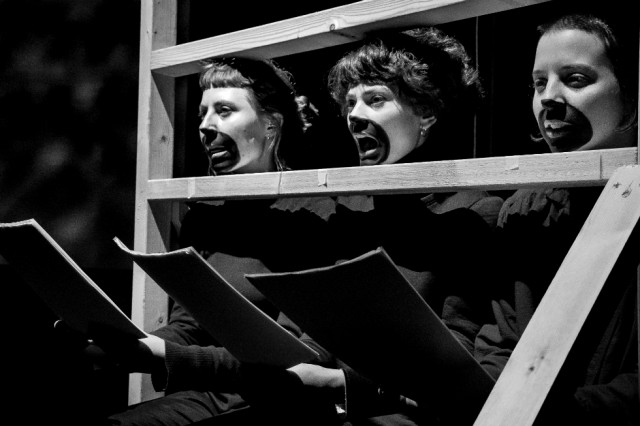Sexual Desire, Pantomime Horses, Cosmic Care Homes… A Weekend of Weird — Reviewed

Can we accurately classify works of art and literature with the word “weird”? Wayne Burrows ponders “an expansive, uncategorisable aesthetic”, and asks whether contemporary reality is weird enough to negate any attempt at creative representation….
Although only attending on the first of two days dedicated to A Weekend of Weird at Loughborough University, an event billed as an “exploration of the emerging field of the Weird, encompassing literature, film, music, art and performance”, it was more than enough to see three newly-commissioned artworks, catch a superbly anarchic film by the late Mike Kelley – and witness at first-hand how the co-option of the word “weird” — an expansive, uncategorisable aesthetic — by institutional academics, mainly concerned with defining and containing it, risks reducing the work embraced to a set of clichés. Even as Howard Phillip Lovecraft’s tentacular fictions were reflexively cited, the creeping, weird horror on display was more likely to be that of academic territory-marking tightening its cold tentacles around the imaginative terrain it set out to celebrate, than the rise of Cthulhu.
This wasn’t only because the morning got off to a lacklustre start, but that didn’t help. The organisers, Nick Freeman and Dan Watt, opened the event with a screening of Andrew Steggall’s short film The Door (2011), a made-for-TV version of an H.G. Wells short story, The Door In The Wall (1911). But far from being weird, or even particularly interesting, The Door turned out to be a banal exercise in upper-middle-class childhood nostalgia. A few pastoral landscape shots, a sequence involving an angel, and former Lovejoy actor Dudley Sutton in a dual role was as eerie as it got. If The Door fell a long way short of the high standards of uncanniness set by 1970s children’s TV, a panel on Arthur Machen, author of The Great God Pan (1894) and The White People (1904), promised more but delivered surprisingly little, given the interest inherent in the subject himself; largely because the panel turned into an unfocused three-way conversation that entirely excluded discussion, the audience or much obvious purpose.
A pattern was emerging, in which this attempt to stake out the weird as an “emerging field” inside institutional English Studies seemed predicated on some fairly sheltered middlebrow assumptions about the potential of fiction and the contrived segregation of a handful of interesting, relatively neglected writers from the longer and more interesting histories that had produced them. It was a commonplace for fin de siecle writers to draw on folkloric, spiritualist and theosophical ideas of one sort or another, but the slightly depressing result of this narrowed focus seemed to be a consensus that the “weird” was little more than a set of standardised generic tropes, linked to some rather ordinary dark fantasy-lite and sub-psychogeographic stylistic tics in our own day, rather than the product of a complex intermingling, over several centuries, of a wide range of Gothic-folkloric and visionary-Surrealist traditions in both English and European writing.

If the initial morning panels, at least, left something to be desired in their engagement with the weekend’s theme, thankfully the performances and films commissioned and curated by Radar as part of Loughborough University’s Arts programme made for a stronger second half to the day, entering the territory with more enthusiasm, less institutional baggage, and a far better grasp on the guiding concept’s more hybrid, uncategorisable and fluid aspects.
Ben Judd’s Who Can Separate Us Now? (2016) occupied the vast space of a gymnasium whose walls were painted in motivational slogans (“Where History Begins” is one that returns to mind as part of the regular institutional décor rather than the performance) with a choreographed sequence that saw small teams of gymnasts gradually moving towards one-another, merging into a large central circle, then sequentially dispersing. Their uniform white leotards were coloured by psychedelic magic lantern slides while a choir sang repetitive but haunting notes and musical phrases made up of the words of the title in various permutations. Carrying a faint air of West Coast cult-ish ritual, with all the optimistic or dystopian connotations this implied, Judd’s piece managed to generate some intriguing atmospherics from its disarmingly basic patterns of sound and movement.
Reactor’s The Gold Ones (ongoing; pictured above and bottom) took a more studiedly chaotic approach, playing out a series of tangentially linked textual and visual skits around an audience corralled within their Cosmic Care Home, set up inside a studio theatre. Presided over by a masked figure named Max Gold, The Gold Ones played like an exercise in sensory overload rather than a work of precise choreography, with digital projections, live and recorded voices, elaborately costumed characters and makeshift sets, some partly demolished by the performers as the event proceeded. Engaging, in a deliberately cartoon-ish manner, and occasionally intense, this was nonetheless probably no more a weird performance than a work made in line with immersive multi-media strategies that have long recent histories in the visual arts. The Gold Ones suggested an intention to work as both absurdist satire on the corporate marketing of privatised services and a pure spectacle making nods to Dada and Futurist cabaret, drawing along the way on video-game aesthetics, aspects of the theatre of Samuel Beckett, and a range of participatory and post-internet strands in current performance.
At least one of Reactor’s precursors might have been Destroy All Monsters, the eclectic Detroit-based collective founded by Mike Kelley, Jim Shaw, Cary Loren and Niagara (aka Lynn Rovner) in 1973 to make films, music, collages, photographs, memorabilia and performances. Skipping the afternoon’s discussion panels in favour of seeing a rare public screening of Kelley’s nearly three-hour long film Day Is Done (2005–6; still pictured below) we were richly rewarded with a thoroughly entertaining series of loosely overlapping episodes involving brightly-coloured dancing pantomime horses, a woman gradually being transformed into the Virgin Mary, a folk-devil telling lascivious jokes, awkwardly posed Nativities, blatantly sexualised psychedelic-pink Pepso-Bismol adverts, small boys in disturbing barbershop vignettes, ludicrous operatics set to a horror-show organ rendition of The Birdie Song, and much else besides.
![weekendofweird-Day is Done [photo Julian Hughes]-slider](http://www.thedoublenegative.co.uk/blog/wp-content/uploads/2017/01/weekendofweird-Day-is-Done-photo-Julian-Hughes-slider-640x426.jpg)
Kelley’s division of the sections into 32 numbered Extracurricular Activity Projective Reconstructions hints at the highly personal therapeutic purpose behind the film’s various scenes and ideas, but Day Is Done is more accessible than this might imply. The total effect is one of uncensored consciousness, a personal memory bank and private imagination overflowing with distorted pop cultural imagery, gleefully unleashing its cathartic energy across the screen. Its general drift is towards a shared, and very particularly contemporary, free-associative sense of the gulf constantly opening between our desires and how we actually exist in the world. Kelley repeatedly wraps traumatic and pleasurable memories alike around archetypes of both the deepest and shallowest kinds, as though it’s impossible to tell the difference. Day Is Done also develops a compelling momentum, probably helped along by its makeshift approach to technical finish.
Following Day Is Done was a tough call, but the day’s third commission was a fresh chapter entitled Phantasmagoregasm from Tai Shani’s ongoing Dark Continent series which could hardly have been more different. Phantasmagoregasm presented a slowly-evolving tableau in which two women moved and occasionally lip-synched to a recorded text, the scenery they inhabited made up of a small stone door with coloured lights embedded and a mortuary slab – like a Henri Fuseli painting of a scene from Gothic author Ann Radcliffe. The story, such as it was, concerned two sisters trapped in a seemingly endless cycle of burying and re-burying the same body, their imaginative worlds shaped by flesh, decay, sexual desire, blood, isolation and – at one joyously incongruous point, anyway – a shared lip-synched sing-along with a verse or two from Beyoncé’s Halo.
The text was as deliberately florid and overwritten as the scenario it described, with the feel of something collaged together, Kathy Acker style, from an 18th century Gothic pot-boiler, some elaborately hormonal fever dreams from a teenager’s diary and Monique Wittig’s 1973 novel The Lesbian Body. The combination seemed to close a circle with the morning’s literary sessions, if only by acting as an oblique commentary on how limited that earlier framing of the weekend’s themes had been. Perhaps, as Mike Kelley’s film certainly did, it also worked to expose the introductory session’s explicitly stated opposition between realistic and fantastical strains of writing – at its clumsiest in a comment from one of the organisers about Arthur Machen’s mythic concerns being opposed to the conventional realism of James Joyce – for the false dichotomy it undoubtedly was.
Instead, what the best work seen at A Weekend of Weird demonstrated was that contemporary reality, or at least, our subjective experience of it, is itself so strange that any representation attempting to capture it will invariably fall outside the limited scope of both literary and genre conventions. Of course, it’s arguable that the works explored from the core canon being more officially defined for this literature (many of them reprinted by publishers like Tartarus Press) do share a cohesive interest in qualities we might plausibly describe as “eerie”, perhaps “neo-Decadent”, though not really “weird”. But even then, attempts to isolate these concerns, or separate them from other species of (sur)realism that encompass all these qualities and more, are liable to become a self-defeating exercise. This isn’t a genre or a niche mode of practice, after all, but a thread that has been part of our stories for as long as we’ve been in possession of the DNA that gave us language and the urge to describe our subjective experience of the worlds we inhabit.
Wayne Burrows
Wayne saw the Weekend of Weird Programme on 26–27 November 2016 at Martin Hall Museum, Loughborough — FREE
Images: All photo credits Juilan Hughes, with thanks





